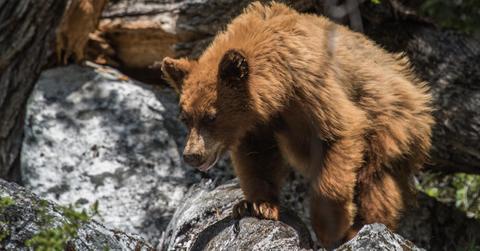
With Yosemite closed to visitors, bears and other animals take over
By Sophie HirshApril 15 2020, Updated 8:15 a.m. ET
With Yosemite National Park closed to tourists due to the COVID-19 pandemic, wildlife has free rein of the 1,187-square mile space — and the local animals are certainly taking advantage. According to Yosemite staff, over the past month, many wild animals have noticed the lack of humans and, in response, have come out of the woods and taken over the park.
“The bear population has quadrupled,” Dane Peterson, an employee of the Ahwahnee Hotel, a lodge in Yosemite Valley, told The Los Angeles Times. “It’s not like they aren’t usually here … It’s that they usually hang back at the edges, or move in the shadows.” Peterson added that over the past few weeks, he and his fellow employees have seen bears, bobcats, and coyotes right outside their cabins and apartment buildings.

Yosemite’s wildlife biologist Ranger Katie, who's worked with black bears in Yosemite for more than 10 years, recently hosted a livestream from Yosemite’s official Facebook page. As reported by ABC7, in the livestream, Katie explained that Yosemite’s bears typically avoid humans when travelling across Yosemite Valley by cutting through corridors. But since the mysterious disappearance of humans, bears have been enjoying the extra space, and walking through areas that are usually congested with visitors.
“For the most part, I think they're having a party. I think that this time of year is difficult for the animals here … There can literally be walls of cars, stop and go traffic or people in the park,” Ranger Katie explained, referring to the park’s bears. “Now that there are no people, the bears are literally just walking down the road to get to where they need to, which is kind of cool to see.”
She also explained the importance of treating the park and all of the wildlife it holds with respect. “Whether we live in this park or visit this park, our behavior has direct consequences for the resources that also make this park their home,” Ranger Katie said, referring to Yosemite’s flora and fauna. “We have the utmost responsibility to be the best stewards of this land that we possibly can.”
Char Miller, a Pomona College historian, believes that Yosemite during the coronavirus closure likely resembles how the park looked in the 1800s. “One thing we can know for sure is that Yosemite is enduring,” he told The Los Angeles Times. “It was here before us, and will remain after we leave.”
On March 18, the NPS waived entrance fees to many National Parks, encouraging Americans to social distance while embracing nature. However, that offer was a bit too enticing, as humans came out to the parks in droves, making social distancing impossible. Within a few days, the NPS had announced closures for a slew of National Parks, including Yosemite.
Yosemite has been closed to the public since March 20, meaning the only people allowed on the grounds are authorized staff and residents of communities within Yosemite National Park, according to the National Park Service (NPS).
In 2019, 4.6 million people visited Yosemite — that roughly breaks down to an average 12,600 people a day, or 383,333 people a month. So for the past month, there have maybe been a few hundred people wandering around Yosemite, compared to the typical hundreds of thousands.
Yosemite is not the only place where wildlife has “returned” amidst coronavirus lockdowns. For example, in Venice, Italy’s canals, fish and swans reportedly came out of hiding; dolphins were spotted in Italy’s Port of Cagliari (though that is not exclusively related to the lockdowns); and in India, reduced air pollution has cleared up skies, allowing people to see the Himalayan mountains from more than 100 miles away for the first time in decades. There’s been so much coverage of wildlife coming out of the shadows during the COVID-19 pandemic that it’s even become a meme.
The best way to prevent contracting or spreading coronavirus is with thorough hand washing and social distancing. If you feel you may be experiencing symptoms of coronavirus, which include persistent cough (usually dry), fever, shortness of breath, and fatigue, please call your doctor before going to get tested. For comprehensive resources and updates, visit the CDC website. If you are experiencing anxiety about the virus, seek out mental health support from your provider or visit NAMI.org.
